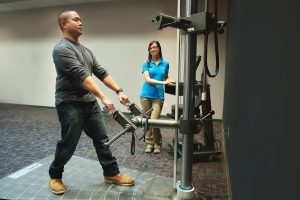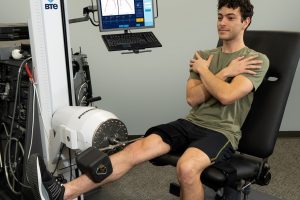
Get Better Data from Your FCEs - Tips and Best Practices
Treatment GuidelinesIf your evaluation meets these requirements, there are a few more ways to make sure you’re performing the most effective FCE and that your client gets the most accurate results. First, make sure your test is as specific to the actual task as possible.
Whether you call it ‘Functional Capacity Evaluation (FCE), ’ ‘Return to Work Evaluation,’ ‘Return to Play Testing,’ or another term, you likely understand the impact FCEs can have on a client’s life and livelihood. The results of a functional performance test can determine whether they are ready to return to their pre-injury job or sport. With major decisions depending on the results, it is paramount to design an evaluation that will give accurate, relevant, and usable data.
These general principals help improve your FCEs and get better data:
- Safety – Ensure the client is safe performing the test. If the test is not safe, you may not have valid or relevant results.
- Relevance – The test has a connection to the performance value you wish to measure.If the test has no relevancy to the task, it is not useful to administer.
- Practicality – The test is reasonable to administer, considering cost and time.
- Usefulness – The results can be applied to referral questions or goal.
If your evaluation meets these requirements, there are a few more ways to make sure you’re performing the most effective FCE and that your client gets the most accurate results. First, make sure your test is as specific to the actual task as possible. Second, use progressive loading. And third, watch for the three types of test termination points.
Specificity of tests
You want to make sure that you are using or designing tests that match the nature of the activity for which you are testing. Not doing so could mean you are testing in a way that is not relevant for that activity.
Your test should match the real-life activity as precisely as possible, whether for employees or athletes. For example, if an athlete is required to make quick directional changes, you wouldn’t perform a quad strength test to asses that ability. If a job description states the worker must lift an object of a specific weight through a specific vertical range, your test should include the same weight and movement pattern (or as close as possible).
How to find physical task requirements
Even though testing specific requirements is the purpose of FCEs, it can be difficult to find those requirements. This is especially true for Return to Work evaluations (RTW), Fit for Duty testing (FFD), or other employment-related evaluations.
In these cases, the ideal employer would provide you with a job description containing specific physical demands information. However, this isn’t always the case. Most likely, you (or someone working on the case) will need to visit the job site to analyze the physical demands.
Progressive loading
To accurately document performance ability, you should build up to the maximum requirement or the most physically demanding activity. Structuring your protocol to start with lighter/easier activities and gradually building to the heavier/more demanding activities ensures a safer test process1. See this example of progressive loading for FCEs:
- Basic screening (Pain, ROM, resting HR and BP)
- Balance and basic movement (walking, submax-cardiovascular testing, dexterity testing)
- Strength testing (isolated open chain and integrated closed chain tests)
- Positional/movement tolerance testing (e.g. reaching, stooping, kneeling, Y-balance test, Functional Movement Screen, etc.)
- Dynamic function specific testing (lifting, carrying, running, pushing, pulling, climbing etc.)
- Job- or sport-specific simulation testing
The concept of progressive loading should be carried out not only across tests, but also within a test. A good example of this is a lifting test where you start with a light load, and gradually add more weight with each repetition.
Test termination points
The final criterion in creating and administering an FCE is knowing when to stop the test. Stopping points can come from a number of observations or objective criteria. The three primary categories for stopping points are biomechanical, physiological, or psychophysical.
Biomechanical stopping point
The biomechanical stopping point follows the biomechanics of the person as they perform the activity. While you will not be able to teach proper body mechanics during the relatively short duration of an FCE, you should encourage proper body mechanics. Ultimately, you will be assessing the client’s capacity as he or she moves in their usual way to complete each task. The biomechanical stopping point relies on your clinical observation skills and knowledge of proper body mechanics.
Physiological stopping point
Physiological response to testing refers to the client’s involuntary reactions to the tests. These reactions include heart rate, blood pressure, respiration rate, changes in pallor, etc. The American College of Sports Medicine recommends keeping the client’s heart rate below 85% of age predicted maximum heart rate (APMHR) during physical demanding testing,with a recovery to 70% APMHR before commencing the next test.2
Psychophysical stopping point
The psychophysical ending point is based on the client’s perceived rate of exertion. That is, how the client feels or perceives the difficulty of the task. You can use scale to rate the perception of the difficulty of a task, such as the Borg Scale3, or simply asking the client to describe their comfort level with that activity. The test should be terminated at the point where the client feels they can no longer continue, and they have reached their maximum performance level.
Task requirement stopping point
A fourth, but still important stopping criteria, is the task requirement. This one applies more to RTW, when you know the specific physical demands of the job tasks, and you are testing the client’s ability to perform them. When the client’s tested ability matches the defined job requirement, you should stop the test. Testing beyond the task requirement could put the client at unnecessary risk.
Safe testing produces usable data
Keeping the client safe during physical performance testing should be your number one priority. Unsafe tests or testing conditions may not only fail to yield useful results, but could aggravate an existing condition. It may even create a new issue that could further limit or delay their return to function.
Every client you test will be different. Your FCE procedure should be customized for each client, with a focus on the activity you are trying to quantify.
The results of FCEs can have a major impact on your clients’ everyday life. Targeting specifically defined movements, using progressive loading, and observing appropriate termination points will ensure that your evaluation yields the most accurate data possible. As a result, you’ll be able to make more informed decisions regarding your clients’ capabilities.
References
- Reiman MP, Manske RC. The assessment of function: How is it measured? A clinical perspective. J Man Manip Ther. 2011 May; 19(2): 91–99.
- American College of Sports Medicine: Guidelines for Exercise Testing and Prescription. (7th ed.) Baltimore: Williams & Wilkins, 2006
- Borg RPE scale © Gunnar Borg, 1970, 1985, 1994, 1998





